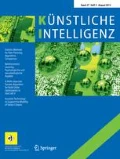Abstract
In this paper we propose a navigation framework for flexible off-road navigation that allows to use different navigation paradigms depending on the given situation. We first classify existing navigation approaches into, global navigation, reactive navigation and guided navigation and then show how a unified view leads to a very flexible navigation architecture that we call affordance hierarchy.

Similar content being viewed by others
Notes
See the video “Lola, der humanoide Laufroboter” at http://www.youtube.com/watch?v=qjBLT1eNkvk.
Here, a “path” is a path through the affordance hierarchy and not a path in the world.
References
Behnke S, Frötschl B, Rojas R, Ackers P, Lindstrot W, Melo MD, Schebesch A, Simon M, Sprengel M, Tenchio O (2000) Using hierarchical dynamical systems to control reactive behavior. In: RoboCup-99: robot soccer world cup III. Springer, London, pp 186–195
Brooks R (1986) A robust layered control system for a mobile robot. IEEE J Robot Autom 2(1):14–23
Brooks RA (1991) Intelligence without reason. Tech rep, Massachusetts Institute of Technology
Buschmann T, Lohmeier S, Schwienbacher M, Favot V, Ulbrich H, von Hundelshausen F, Rohe G, Wuensche HJ (2010) Walking in unknown environments—a step towards more autonomy. In: International conference on humanoid robots, Nashville, USA
Dellaert F, Fox D, Burgard W, Thrun S (1999) Monte Carlo localization for mobile robots. In: Proceedings of the IEEE international conference on robotics and automation (ICRA)
Dickmanns ED (1994) The 4d-approach to dynamic machine vision. In: Proceedings of the 33rd IEEE conference on decision and control, vol 4, pp 3770–3775
Dickmanns ED (2004) Dynamic vision-based intelligence. AI Mag 25(2):10–30
Dickmanns ED, Mysliwetz BD (1992) Recursive 3-d road and relative ego-state recognition. IEEE Trans Pattern Anal Mach Intell 14:199–213
Dissanayake MWMG, Newman P, Clark S, Durrant-Whyte HF, Csorba M (2001) A solution to the simultaneous localization and map building (slam) problem. IEEE Trans Robot Autom 17:229–241
Eliazar A, Parr R (2004) Dp-slam 2.0. In: Robotics and automation, 2004. 2004 IEEE international conference on proceedings ICRA ’04, vol 2, pp 1314–1320
Gibson JJ (1977) The theory of affordances. Erlbaum, Hillsdale
Hart P, Nilsson N, Raphael B (1968) A formal basis for the heuristic determination of minimum cost paths. IEEE Trans Syst Sci Cybern 4(2):100–107
Himmelsbach M, von Hundelshausen F, Wünsche HJ (2008) LIDAR-based perception for offroad navigation. In: Stiller C, Maurer M (eds) Proceedings of FAS 2008, Fahrerassistenzsysteme workshop 2008, Walting, Germany
Himmelsbach M, von Hundelshausen F, Luettel T, Manz M, Mueller A, Schneider S, Wuensche HJ (2009) Team MuCAR-3 at C-ELROB 2009. In: Proceedings of 1st workshop on field robotics, civilian European land robot trial 2009, University of Oulu, Oulu, Finland. ISBN:978-951-42-9176-0
Himmelsbach M, Luettel T, Hecker F, von Hundelshausen F, Wuensche HJ (2010) Autonomous off-road navigation for MuCAR-3. Künstl Intell. doi:10.1007/s13218-011-0091-1
Jaeger H, Christaller T (1998) Dual dynamics: designing behavior systems for autonomous robots. Artif. Life Robot. 2(3):108–112
Kammel S, Ziegler J, Pitzer B, Werling M, Gindele T, Jagzent D, Schröder J, Thuy M, Goebl M, von Hundelshausen F, Pink O, Frese C, Stiller C (2008) Team annieway’s autonomous system for the DARPA urban challenge 2007. Int J Field Robot Res
Luettel T, Himmelsbach M, von Hundelshausen F, Manz M, Mueller A, Wuensche HJ (2009) Autonomous offroad navigation under poor GPS conditions. In: Proceedings of 3rd workshop on planning, perception and navigation for intelligent vehicles (PPNIV), IEEE/RSJ international conference on intelligent robots and systems, St Louis, MO, USA
Möller R, Krzykawski M, Gerstmayr L (2010) Three 2d-warping schemes for visual robot navigation. Auton Robots
Pellkofer M (2003) Verhaltensentscheidung für autonome Fahrzeuge mit Blickrichtungssteuerung. Dissertation, Universität der Bundeswehr München
Proetzsch M, Luksch T, Berns K (2010) Development of complex robotic systems using the behavior-based control architecture ib2c. Robot Auton Syst 58(1):46–67
Rusinkiewicz S, Levoy M (2001) Efficient variants of the icp algorithm. In: Proceedings of the third intl conf on 3D digital imaging and modeling, pp 145–152
Schleicher D, Bergasa LM, Ocaña M, Barea R, Guillén MEL (2007) Real-time stereo visual slam in large-scale environments based on sift fingerprints. In: Moreno-Díaz R, Pichler F, Quesada-Arencibia A (eds) EUROCAST. Lecture notes in computer science, vol 4739. Springer, Berlin, pp 684–691
Strasdat H, Montiel JMM, Davison A (2010) Scale drift-aware large scale monocular slam. In: Proceedings of robotics: science and systems, Zaragoza, Spain
Voemir Kunchev Lakhmi Jain VI, Finn A (2006) Path planning and obstacle avoidance for autonomous mobile robots: a review. Lecture notes in computer science, vol 4252. Springer, Berlin
von Hundelshausen F, Himmelsbach M, Hecker F, Mueller A, Wuensche HJ (2008) Driving with tentacles: integral structures for sensing and motion. J Field Robot 25(9):640–673
Werling M, Gröll L, Bretthauer G (2010) Invariant trajectory tracking with a full-size autonomous road vehicle. Trans Robot 26(4):758–765
Author information
Authors and Affiliations
Corresponding author
Rights and permissions
About this article
Cite this article
von Hundelshausen, F., Luettel, T. & Wuensche, HJ. Cognitive Navigation. Künstl Intell 25, 125–132 (2011). https://doi.org/10.1007/s13218-011-0092-0
Received:
Accepted:
Published:
Issue Date:
DOI: https://doi.org/10.1007/s13218-011-0092-0




